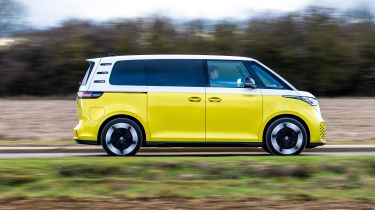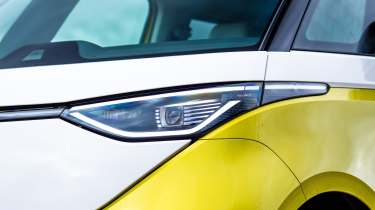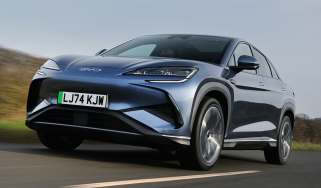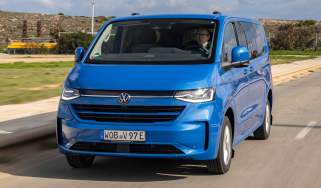Volkswagen ID. Buzz review - Range, charging & running costs
"The ID.Buzz is expensive to buy, but ultra-fast charging is a welcome addition"
The ID. Buzz uses battery packs familiar to the rest of the ID range, but its large size and extra weight means range figures are slightly down on smaller models like the ID.3 hatchback. Still, it should be possible to drive further than most would want to in a single day behind the wheel, and the Buzz can charge quickly.
VW is also making a big deal about sustainable production; you won’t find any leather in the ID. Buzz, and some of its upholstery is made from recycled bottles and plastics recovered from the ocean. Volkswagen has also committed to taking back the batteries at the end of their life, so they can be repurposed – in applications like home energy storage – or recycled.
Volkswagen ID. Buzz range & charging
The standard Volkswagen ID. Buzz launched with a 77kWh battery pack, but this is increased to 79kWh for 2024. According to the official WLTP figures, this gets up to 282 miles of range, up from the original 257 miles.
Volkswagen has also introduced a long-wheelbase variant of the ID. Buzz which has room to incorporate a larger 86kWh battery. As a result, its range doesn’t differ too far from the standard wheelbase model, so it’s capable of up to 290 miles to a charge despite the extra weight. The high-performance ID. Buzz GTX comes with a range figure of up to 254 miles in short-wheelbase guise, while the long-wheelbase GTX can do up to 280 miles.
In standard form, the ID. Buzz can manage up to 185kW at a suitable public chargepoint, while 86kWh battery versions can charge at speeds of up to 200kW. That means charging the smaller battery from 10-80% will take just under half an hour in either guise. giving the MPV significantly longer legs if you don’t mind taking a break.
More reviews
Despite its size and number of seats, the ID. Buzz’s electric powertrain means it’s exempt from VED (road tax) until the rules change in April 2025, after which it will cost £10 in the first year, and the standard annual rate thereafter. It also falls into the most affordable Benefit-in-Kind company car tax band, making it all the more appealing for businesses and company-car drivers. The exemption for EVs from the £40,000 expensive car supplement is also due to end in 2025, however, so ID. Buzz buyers will have to pay an additional sum on top of road tax from the second year until the sixth year of the car’s life.
Insurance groups
The Volkswagen ID. Buzz sits between groups 31 and 33 out of 50, so it’s not the cheapest car to insure. It’s still to be seen, but the upgrades to a more potent motor and larger battery, not to mention the hot GTX could see the ID. Buzz reach even higher groups, though these are yet to be confirmed.
Servicing
There are far fewer serviceable parts on an electric car, which doesn’t have spark plugs, a clutch or cambelt, let alone any engine oil. This should make the ID. Buzz cheaper to maintain than a Volkswagen Multivan, but the braking system, climate control and other systems still need checking and maintaining. We expect the Buzz will need servicing the same amount as the ID.4, which requires a visit to the dealership every two years.
Warranty
Volkswagen covers all of its models for three years/60,000 miles, but the ID. Buzz should also benefit from a longer eight-year/100,000-mile battery cover, to reassure buyers wary of the new technology failing prematurely.



















